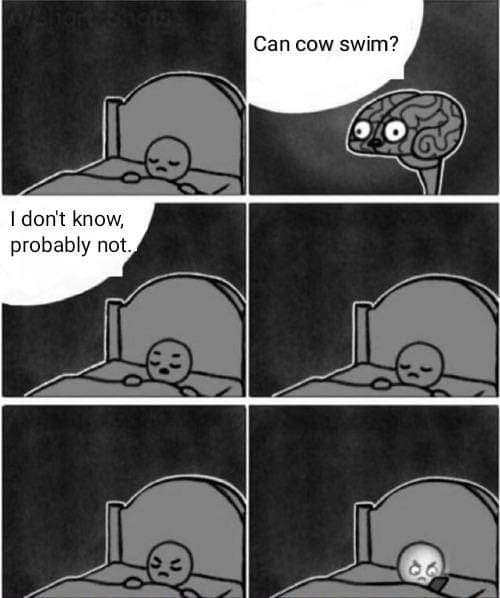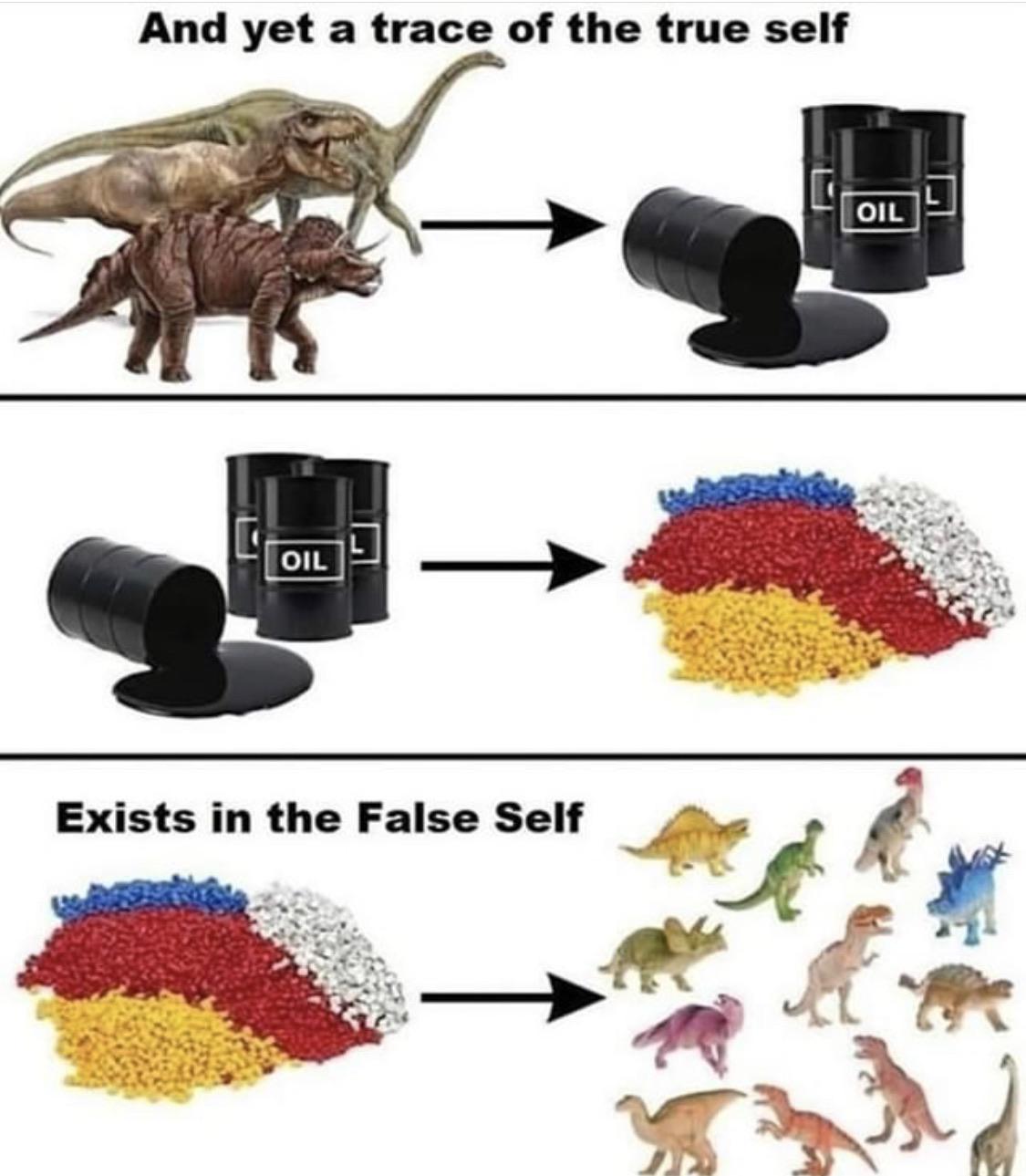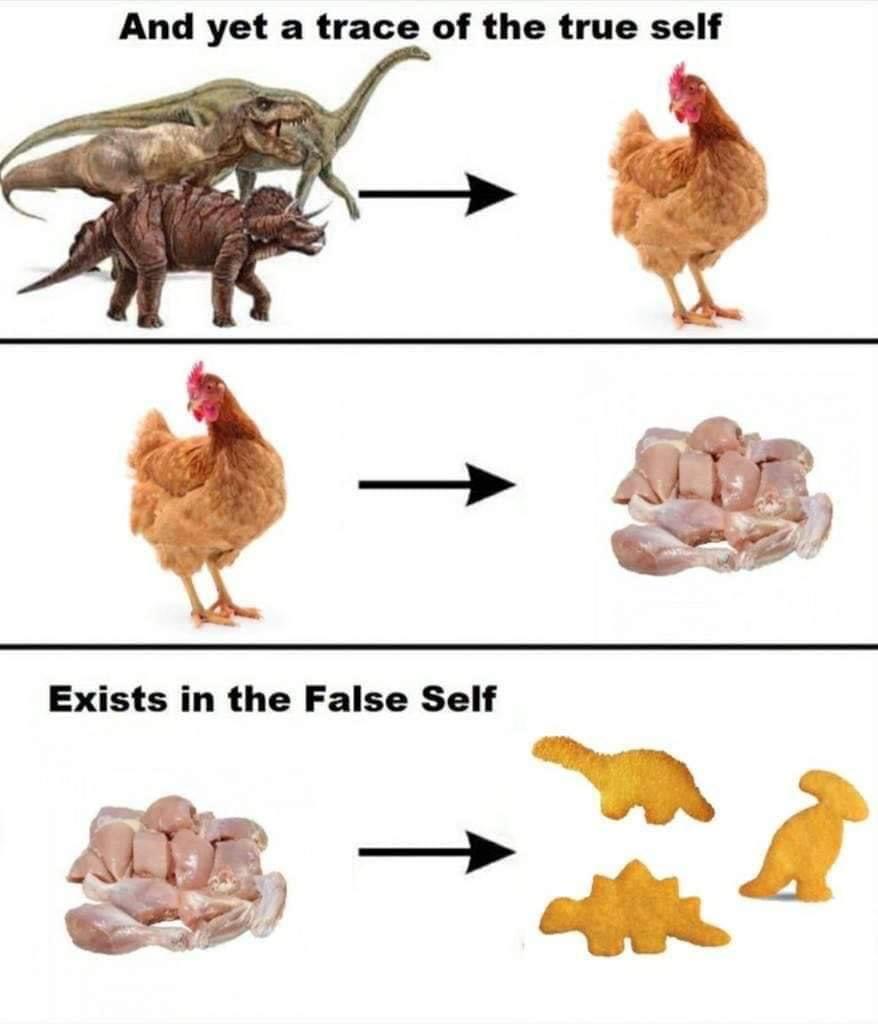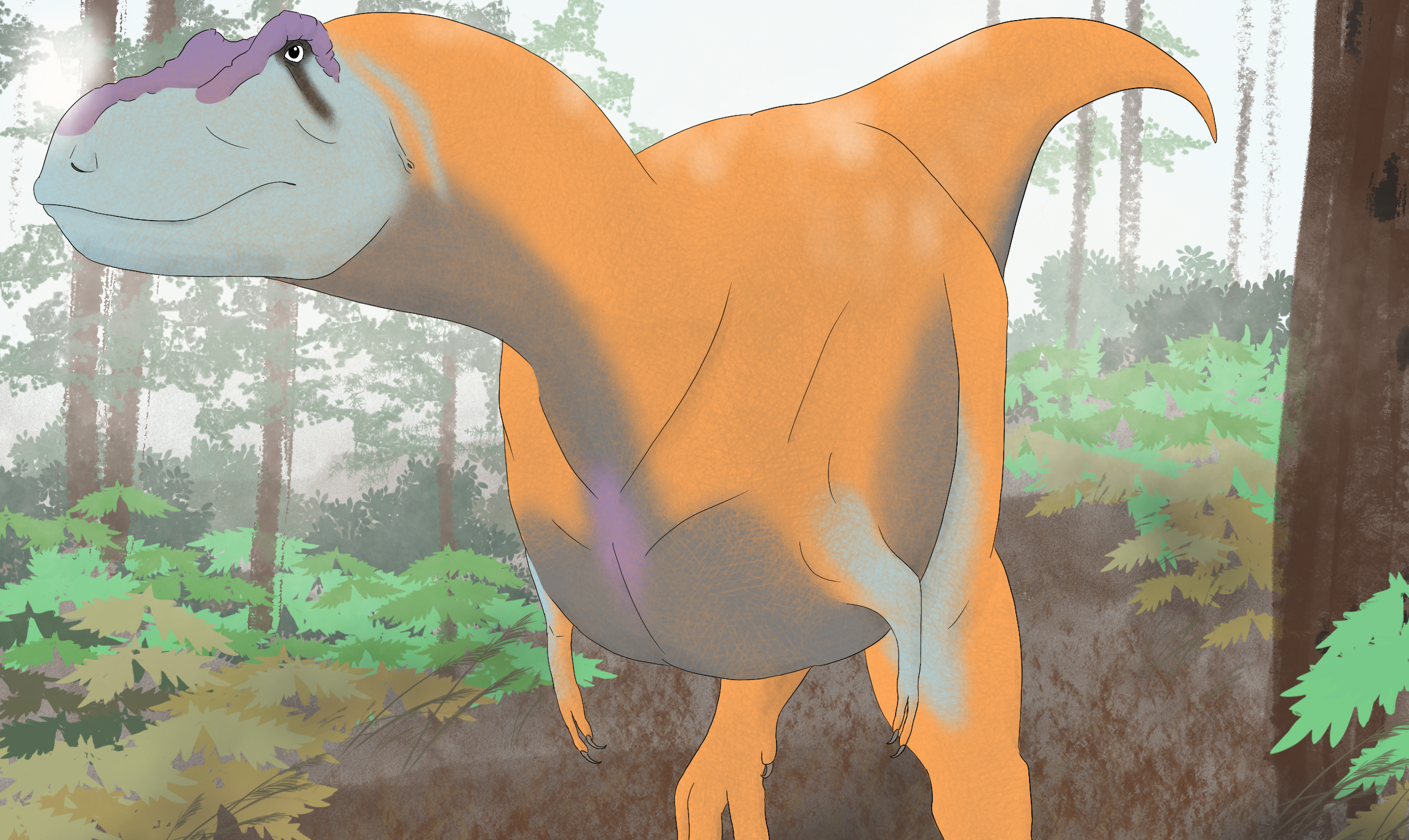I was browsing Reddit and came across this comic, which I loved:

This happens to me a lot. After going through this enough times, I have a sufficiently long list of interesting questions to merit a blog post. Here’s a somewhat unstructured list of answers to questions about everyday biological phenomena.
So, can cow swim?
Short answer: yes. In fact, they’re pretty decent at it.
Long answer: Turns out, essentially every mammal instinctively knows how to swim, except great apes (and possibly giraffes, though this is only hypothesized based on computer modeling). I was pretty surprised to learn that even bats and sloths can swim when they must. Why? And what makes apes special?
There are two factors that are important for swimming: buoyancy and stroke motion. Since nearly all mammals are warm-blooded, we have a layer of insulating fat to slow heat loss, which increases buoyancy. Many herbivores have a lot of gas inside their digestive systems, which also helps them float (this latter reason may be why cows are better swimmers than they look). Regarding stroke motion, most mammals are quadrupeds, which means their heads are at about the same elevation as their center of mass, giving them a natural floating posture similar to their normal posture on land. Furthermore, the motions required to doggy paddle are essentially the same as the motions required to run on all fours, making swimming an intuitive extension of an already well-used motor skill.
Apes have none of these advantages. We have low body fat (in fact, even healthy humans have a much higher body fat percentage than the primate average, but it’s still lower than that of most mammals) and don’t have the fermenting gut that creates internal gas. Apes are bipeds or semi-bipeds with a center of mass much lower than our heads, so if we just fill our lungs and passively float, we rotate into a very different posture than we’re used to, with our heads facing down into the water. And the motion required to stay afloat is a completely different one than anything we do outside the water. When a human who can’t swim ends up in water, they instinctively try to stay upright and use their arms to push down on the water in an attempt to push themselves up. This doesn’t work because the act of raising their arms out of the water reduces their buoyancy, causing their head to go under. Chimps and orangutans exhibit similar behavior when they end up in water, which is why zoos often use moats to keep apes inside their enclosures. Similarly to humans, apes can learn how to swim if taught, and some have successfully learned the breaststroke.
So, it’s not just one reason, but the effect of many factors combined that cause apes to be unable to instinctively swim. Unlikely swimmers like sloths have a habitual posture that’s very different from their natural floating posture and very low body fat, but their fermenting guts produce enough gas to allow them to float. Bats have low body fat and no fermenting gut, but they have a floating posture similar to their flying posture, and the motion they use to swim is essentially the same one they use to fly. It seems that having any one of these features is sufficient for swimming, but apes happen to have none.
Here’s a good BBC article that explores this in a bit more detail (and interviews Darren Naish, paleontologist rockstar and the guy who modeled the swimming giraffe).
How does hair know when to stop growing?
The hair on your forearms never gets longer than an inch or so, but the hair on your head seems to be able to grow to infinite length. Why?
The maximum length that hair can achieve is dictated by two factors: growth rate and lifetime, both of which vary between people and between locations on the body. The hair on your arms has a short lifetime, so it falls out before it can get very long. Each hair on your head can stick around for up to a decade, allowing it to get very long (but not infinitely long). The reason hair appears to “know” how long it’s supposed to be is because there are a lot of them, so we don’t see each individual hair going through its cycle; rather, the length of the longest ones appears to be the length of all of them. In reality, you have hairs of every length on your head (the shorter ones are the “baby hairs” that come out of a ponytail and make you look disheveled).
When you get your hair cut short, it seems thicker than when it was long. This is because more of the hairs are now at the maximum length. If you then let it grow back out, it will seem to grow back thinner than before. This is because only the hairs that were in the growth phase of their life cycles are making up that extra length; the ones that were in the maintain or fall out phases will fall out short and have to start over again from the beginning. If you give it more time, it will go back to being as thick as it was. This provides new insight to the old-wives practice of shaving a baby’s head to make their hair “grow back thicker”. When you shave it, it does appear initially thicker, but when you let it grow out it will appear thinner, and over a long timespan it will have had no effect.
How do tongues work?
Tongues, as well as octopus tentacles and elephant trunks, are known as “muscular hydrostats”. While skeletal muscles exert forces by pulling on your bones and smooth muscles pull on networks of filaments that run throughout them, muscular hydrostats are just blobs of muscle that function on the principle that water (which muscle is mostly made of) is incompressible, so the total volume of the hydrostat must remain constant. Compressing one end causes expansion at the other, and compressing one end hard while compressing the other less hard causes both expansion and stiffness. Since the muscle fibers that form a muscular hydrostat can be oriented in many directions and operate independently, hydrostats are capable of a much larger variety of movements, shapes, and textures than other types of muscles. Octopuses, which have eight of these, are super strong and dextrous, able to lift many times their weight and manipulate objects in myriad ways.
So if muscular hydrostats are so great, why don’t more animals use them as their primary limbs? They require a lot of brainpower to operate. Seventy percent of an octopus’s neurons are located in its arms and are used to control them. Brain is the most metabolically expensive tissue, so if an animal can get by with less dexterity and strength, it’s advantageous to use that brainpower for other purposes (or to minimize it).
A related structure to a muscular hydrostat is a hydrostatic skeleton, which is a tube of muscle filled with liquid, like the body of a flatworm or a mammalian penis. It works on a similar principle but is capable of less diverse movements, since the muscle is all located on the periphery.
Do some people really lack internal monologue?
Recently, you may have heard some people claiming that they don’t have an inner voice, but think in ideas or visuals. Is this true, or is it just a failure of introspection or a desire to be special that leads to these claims? This is actually a question that hasn’t been thoroughly researched, so the below answer is my own thought process, research, and conclusion. So feel free to reach out and debate if you disagree!
The experience of being a human is largely similar from one individual to the next, with differences being a matter of degree rather than of kind. We don’t have a lot of genetic diversity as a population, and since evolutionary adaptations pile up into configurations of irreducible complexity, you generally can’t just add, remove, or swap features without causing adverse effects elsewhere. For example, it’s extremely unlikely for a person to be unable to make a peace sign with their hand, and that’s it. Such an inability would be a symptom of a larger issue, like a hand deformity or brain damage.
What about the ability to smell or taste certain things, such as the aldehydes that make cilantro taste like soap or the bitter chemical PTC (often used in classrooms to teach Mendelian genetics and Punnett squares)? Those are real examples of different people experiencing the same phenomenon totally differently. But smell and taste are actually special cases because of the way that they function. To detect a smell, you have to have a receptor in your nose specific to that smell or a molecular component of it. You have an army of differently shaped molecular receptors in your nose, most of which are doing nothing most of the time. It’s an inefficient but modular system–receptors can be removed without affecting the overall system’s functionality, and doing so can save metabolic resources. The ancestral state is actually having all the receptors, and over time different groups of animals have shut down parts of the genome that make receptors they no longer need. As an extreme case, dolphins and whales still have the genes to make all the different smell receptors, but all of them have been deactivated.
What about aphantasia, the inability to make mental images, or prosopagnosia, the inability to recognize faces? Those are phenomena that are better studied than lack of internal monologue, and are proven to exist. Check out Blake Ross’s (the co-creator of Firefox) essay about his experience of finding out he had aphantasia for answers to common questions (and a very entertaining time). Unlike purported lack of internal monologue, aphantasia is a form of brain damage, which comes about due to congenital deformity or trauma, and affects other things like memory and emotional response. While the simple description “inability to form mental images” implies that it’s a modular change to perceptual experience, it’s actually a much more complicated phenomenon. The description of prosopagnosia as the inability to recognize faces is similarly misleading, but in a different way–prosopagnosia can occur in varying degrees of severity and in different types.
While lack of internal monologue obviously exists among animals that can’t use language, I am highly skeptical that it exists among ones that can. If someone can form their thoughts into words, that means that even if their original thought was just an image or idea, there needs to be translation going on somewhere in the brain, which can be considered an internal monologue. Some people may not habitually monitor that part of their brain, and some people may just not think very much when they’re by themselves, but it seems to me that anyone who can talk must have an internal monologue. The monologue may manifest itself differently in different people–perhaps writers type out their thoughts, or deaf people perform internal sign language–but it seems to me that the only people who truly lack an internal monologue are those with aphasia, the inability to produce or understand language.
What are fossil fuels really made of, and why are they not forming anymore?

Sinclair Oil Corporation, of the gas stations with the sauropod logo, used the idea that fossil fuels are made of dinosaurs as a fun marketing strategy. At the Chicago World’s Fair in 1933-34 and again at the New York World’s Fair in 1964-65, Sinclair sponsored dinosaur exhibits with giant animatronic models, many of which are still on display today. When I was in Washington, D.C., and visited the National Zoo, I didn’t realize at the time that the Triceratops statue there was one of Sinclair’s 1964 originals.
However, fossil fuels are not actually made of dinosaurs; they come from the bodies of ancient plants (which became coal, methane, and natural gas) and algae (which became petroleum and natural gas). A majority of the Earth’s coal is made of the wood of a single genus of plant, Lepidodendron, which proliferated across the globe during the Carboniferous Period and moved so much carbon from the atmosphere into storage as wood that it caused a short but intense ice age. Back then, wood was a new invention that decomposers had not yet figured out how to digest, so instead of carbon being released back into the atmosphere by the decomposition process, tons of wood just piled up and eventually was buried and fossilized. Nowadays, fungi decompose wood before it can fossilize unless it is rapidly buried, sinks to the bottom of an anoxic lake, or other such special circumstances.
Why is wood so hard to digest? It contains a substance called lignin, which is a polymer, which means it’s a giant molecule formed from lots of repeating subunits (monomers). Plastics are also examples of polymers, and they’re hard for decomposers to break down for the same reason lignin is: the subunits are linked together in many, many places, and in all kinds of different configurations. This makes them very strong, since large chunks of the substance are essentially single enormous molecules held together by chemical bonds. And, since the internal structure is chaotic due to the monomers linking to each other in a variety of ways, no single enzyme (a molecular “key” that can open specific shapes of molecular “lock”) will do the trick. Enzymes are the main tool in most living things’ metabolic toolbox, and a completely different approach had to arise before wood could be broken down.
Eventually, fungi discovered a different way to break substances down chemically: through the use of free radicals. These are a type of small, unstable molecule that will chemically react with basically anything. Fungi are able to produce a spray of assorted radicals, which are able to react with atoms in a polymer and chip away at it by forming other substances that aren’t chemically bonded to the polymer anymore. This strategy probably evolved as a quicker and more versatile way to digest unfamiliar substances, in order to make the most of what resources were available. If a fungus doesn’t have the right enzyme for the job, instead of trying every possible enzyme shape (similar to trying to brute-force guess a password), it can just unleash a deluge of free radicals that will do the job messily but effectively. This is also how conservationists are hoping fungi can be bred or trained to digest petroleum, plastic, and nuclear waste.
Anyway, back to the main question. As I mentioned before, algae can also become fossil fuel, and those don’t have any wood. So how did algae-based fossil fuels ever form if they’ve always been biodegradable, and if they could form then, why not now?
Algae-based fossil fuels form in conditions of very low oxygen, such as the bottoms of stagnant lakes, where decomposers cannot live. When they die, they sink to the bottom and are eventually covered by sediment, which, when it piles up high enough (at depths of about 2km or more), creates enough heat and pressure to (*waves hands*) slowly turn the algae into crude oil, which, if buried even deeper, can then become natural gas. The whole process from alga to oil takes a minimum of 40 million years. New petroleum is still being formed, but by my rough calculation, it’s formed at a rate of about 6,300 tonnes per year. In 2016 (I wasn’t able to find more recent global data) we consumed 5.2 billion tonnes. That’s around a million times more than was produced.
It’s possible–even probable–that at some point between 100 and 65 million years ago, a dinosaur sank to the bottom of an anoxic lake and became part of an oil deposit. Dinosaurs just don’t make up an appreciable fraction of the total biomass involved. A more accurate version of the above meme would be something like this:


